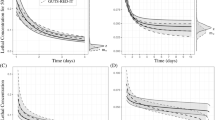Abstract
The Human Toxicity Potential (HTP) is a quantita tive toxic equivalency potential (TEP) that has been introduced previously to express the potential harm of a unit of chemical released into the environment. HTP includes both inherent toxicity and generic source-to-dose relationships for pollutant emissions. Three issues associated with the use of HTP in Life Cycle Impact Assessment (LCIA) are evaluated here. First is the use of regional multimedia models to define source-to-dose relationships for the HTP. Second is uncertainty and variability in sourceto-dose calculations. And third is model performance evaluation for TEP models. Using the HTP as a case study, we consider important sources of uncertainty/variability in the development of source-to-dose models — including parameter variability/uncertainty, model uncertainty, and decision rule uncertainty. Once sources of uncertainty are made explicit, a model performance evaluation is appropriate and useful and thus introduced. Model performance evaluation can illustrate the relative value of increasing model complexity, assembling more data, and/or providing a more explicit representation of uncertainty. This work reveals that an understanding of the uncertainty in TEPs as well as a model performance evaluation are needed to a) refine and target the assessment process and b) improve decision making.
Similar content being viewed by others
References
Guinée JB, Heijungs R (1993): A proposal for the classification of toxic substances within the framework of life cycle assessment of products. Chemosphere26, 1925–1944
Hertwich EG, Pease WS, Koshland CP (1997): Evaluating the environmental impact of products and production processes: A comparison of six methods. Sci Total Environ196, 13–29
Hofstetter P (1998): Perspectives in Life Cycle Impact Assessment: A structured approach to combine models of the technosphere, ecosphere and valuesphere. Kluwer, Boston
Udo de Haes HA, Jolliet O, Finnveden G, Hauschild M, Krewitt W, Müller-Wenk R(1999): Best available practice regarding impact categories and category indicators in Life Cycle Impact Assessment. Int. J. LCA (4) 67–74
Hertwich EG (1999) Toxic Equivalency: Accounting for human health in Life Cycle Impact Assessment. Ph.D. thesis, University of California, Berkeley, USA
Hertwich EG, Mateles SF, Pease WS, McKone TE (2001): Human toxicity potentials for life cycle analysis and toxics release inventory risk screening. Environ Toxicol Chem20, 928–939
McKone TE (1993): CalTOX, A multimedia total exposure model for hazardous-waste sites UCRL-CR-111456PtI-IV. Lawrence Livermore National Laboratory report, Livermore, CA, http://www.cwo. com/-herdl/caltox.htm
Maddalena RL, McKone TE, Layton DW, Hsieh DPH (1995): Comparison of multi-media transport and transformation models—regional fugacity model vs CalTOX. Chemosphere30, 869–889
Cowan CE, Mackay D, Feijtel TCJ, van de Meent D, Di Guardo A, Davies J, Mackay N (1995): The multi-media fate model: A vital tool for predicting the fate of chemicals. SETAC Press, Pensacola, Florida, USA
Morgan GM, Henrion M (1990): Uncertainty: A guide to dealing with uncertainty on quantitative risk and policy analysis. Cambridge University Press, Cambridge, UK
Finkel AM (1990): Confronting uncertainty in risk management — A guide for decision-makers. Resources for the future. Washington D.C., USA
Hertwich EG, McKone TE, Pease WS (1999): Parameter uncertainty and variability in evaluative fate and exposure models. Risk Analysis19, 1193–1204
Hertwich EG, McKone TE, Pease WS (2000): A systematic uncertainty analysis of an evaluative fate and exposure model. Risk Analysis20, 439–454
Oreskes N, Shrader-Frechette K, Belitz K (1994): Verification, validation and confirmation of numerical models in the earth sciences. Science263, 641–646
Buckland ST, Burnham KP, Augustin NH (1997): Model selection: An integral part of inference. Biometrics53, 603–618
Hodges JS, Dewar JA (1992) Is it you or your model talking: A framework for model validation. Rand Publications, Santa Monica California, USA (R-4114-AF/A/OSD)
Bredehoeft JD, Konikow LF (1993): Ground water models: validate or invalidate. Ground Water31, 178–179
Beck MB, Ravetz JR, Mulkey LA, Barnwell TO (1997): On the problem of model validation for predictive exposure assessment. Stochastic Hydrology and Hydraulics11, 229–254
Author information
Authors and Affiliations
Corresponding authors
Rights and permissions
About this article
Cite this article
McKone, T.E., Hertwich, E.G. The human toxicity potential and a Strategy for Evaluating Model Performance in Life Cycle Impact Assessment. Int. J. LCA 6, 106–109 (2001). https://doi.org/10.1007/BF02977846
Issue Date:
DOI: https://doi.org/10.1007/BF02977846




